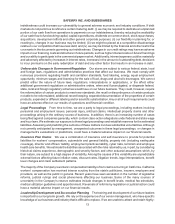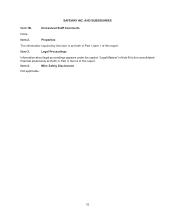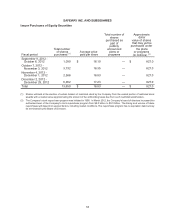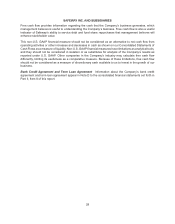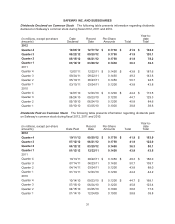Safeway 2012 Annual Report Download - page 35
Download and view the complete annual report
Please find page 35 of the 2012 Safeway annual report below. You can navigate through the pages in the report by either clicking on the pages listed below, or by using the keyword search tool below to find specific information within the annual report.SAFEWAY INC. AND SUBSIDIARIES
23
in the Canadian dollar exchange rate and a $254 million decline in sales due to the disposition of Genuardi's
stores. Average transaction size increased during fiscal 2012, and transaction counts decreased.
Sales increased 6.3% to $43.6 billion in 2011 from $41.1 billion in 2010. Fuel sales increased $1,408.7 million
in 2011, as a result of the average retail price per gallon of fuel increasing 23.8% and gallons sold increasing
16.5%. Additionally, the change in the Canadian dollar exchange rate resulted in a $240.0 million increase
in sales. Identical-store sales, excluding fuel, increased 1.0%, or $375 million, primarily due to inflation.
Average transaction size increased during 2011, and transaction counts decreased slightly.
Prior to 2011, Safeway recorded Blackhawk Network distribution commissions on the sale of certain gift
cards, net of commissions shared with other retailers. In the first quarter of 2011, Safeway determined that
these commissions should be reported on a gross basis. This change increased both revenue and cost of
goods sold in fiscal 2011 by $413.5 million but had no impact on identical-store sales, gross profit dollars or
net income. Previously reported results are not adjusted because the impact is immaterial.
Gross Profit Gross profit represents the portion of sales revenue remaining after deducting the cost of
goods sold during the period, including purchase and distribution costs. These costs include inbound freight
charges, purchasing and receiving costs, warehouse inspection costs, warehousing costs and other costs
associated with Safeway’s distribution network. Advertising and promotional expenses are also a component
of cost of goods sold. Additionally, all vendor allowances are classified as an element of cost of goods sold.
Gross profit margin was 26.51% of sales in 2012, 27.03% of sales in 2011 and 28.28% in 2010.
The gross profit margin decreased 52 basis points to 26.51% of sales in 2012 from 27.03% of sales in 2011.
The impact from fuel sales decreased gross profit margin 30 basis points. The remaining 22 basis-point
decline was largely the result of a 13 basis-point decline due to investments in price and a seven basis-point
decline from costs incurred to launch just for U, partly offset by a nine basis-point improvement from lower
LIFO expense.
The gross profit margin decreased 125 basis points to 27.03% of sales in 2011 from 28.28% of sales in
2010. The impact from fuel sales decreased gross profit margin 80 basis points. The remaining 45 basis-
point decline was largely the result of a 53 basis-point decline due to cost increases and investments in
price, a 32 basis-point decline from the change in the reporting for gift card commissions and a 16 basis-
point decline resulting from LIFO expense, partly offset by a 34 basis-point improvement in shrink and a 13
basis-point improvement from Blackhawk contributions.
Shrink expense was essentially flat, as a percentage of sales, in 2012. Shrink improved gross profit 34 basis
points in 2011 and 19 basis points in 2010. Safeway's long-term programs to control shrink expense include
improved buying practices to prevent overstocking of inventory and increased security to reduce theft. These
programs have been very successful in recent years, and we believe we can continue to further reduce
shrink in the future. However, shrink can never be completely eliminated, and consequently, shrink
improvement cannot continue indefinitely.
Vendor allowances totaled $3.0 billion in 2012, $2.9 billion in 2011 and $2.9 billion in 2010. Vendor allowances
can be grouped into the following broad categories: promotional allowances, slotting allowances and contract
allowances.
Promotional allowances make up the vast majority of all allowances. With promotional allowances, vendors
pay Safeway to promote their product. The promotion may be any combination of a temporary price reduction,
a feature in print ads, a feature in a Safeway circular or a preferred location in the store. The promotions are
typically one to two weeks long.


